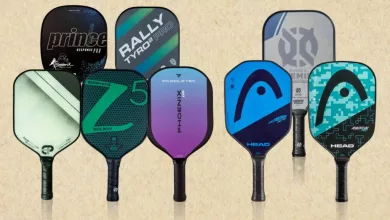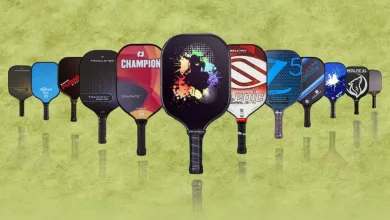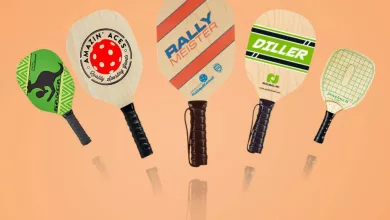Graphite vs Fiberglass Pickleball Paddles: A Detailed Comparison
Table of Contents
When researching pickleball paddles, it becomes clear that there are several different types. There are graphite, fiberglass, carbon fiber, wooden, and composite paddles. These can be very confusing when first purchasing a paddle. Selecting the right pickleball paddle can transform your game because it greatly impacts the players’ control, spin, and power. Therefore, it’s very important to buy the right pickleball paddle. However, the most common issue is the availability of pickleball paddles in two different materials. As a result, many players end up spending a lot of money trying different paddles to find the suitable one for their playing style. But you don’t need to worry! We have a graphite vs. fiberglass paddle detailed comparison to help you choose the right paddle for your play-style.
Graphite Vs. Fiberglass pickleball paddles – Characteristic Comparison
A pickleball paddle is not made up of a single element. It consists of three parts: handle, face and core. Each of these parts is designed differently. Graphite and fiberglass are used for face and handle grip, and Nomex, polypropylene and aluminum are used for core building. Hence, each face and core material plays a different role in a player’s strength, grip, durability and playing style. Even though the core plays a vital role in power and strength, today we will discuss two face materials: graphite vs. fiberglass and their impact on pickleball players.
Basic Characteristics
Both graphite and fiberglass paddles are lightweight layered sheets of respective material favored by many players. Let’s check the basic characteristics of each material.
Fiberglass:
- Very versatile and durable material.
- It can withstand the rigors of aggressive players.
- It’s not as stiff as graphite. Thus, it suits a more power-driven style and hard-shot hitters.
- It features a larger sweet spot, providing a better hitting surface.
Graphite:
- Very light and rigid.
- Aid in balanced shots due to the material’s stiffness.
- Provide a consistent strike and greater energy transfer between the ball and the paddle.
- It’s good for strategic pro players rather than power hitters.
Control
A firm grip and control are really important in pickleball games. Therefore, we must understand how each face material affects the player’s control. In this regard, I would say graphite paddles take the lead. The smooth surface of graphite allows for high precision and accuracy in your shots, whether you’re aiming for a soft dink or a spot-on placement.
In contrast, a fiberglass face provides less control over the paddle needed to execute these shots effectively. It tends to give consistency and stability more than control. The added weight and slightly rougher texture of fiberglass paddles can help you maintain a steady and predictable performance, which is especially advantageous for beginners.
Speed
Fiberglass pickleball paddles are faster than graphite paddles. They hit the ball faster because fiberglass is flexible. Thus, it helps players add power to their shots with less effort. So, fiberglass paddles are good for professional players who hit aggressive and fast shots. Graphite paddles, on the other hand, are a bit slower in terms of shot speed. Still, it offers better control, which is great for planned shots. Hence, the choice between the two depends on whether a player wants more speed or control.
Spin
Spin is a crucial element in pickleball, and your choice of paddle can influence your spin abilities.
Both graphite and fiberglass pickleball paddles provide a high level of spin control. However, the smooth surface of graphite allows players to grip the ball better vs. fiberglass textured surface. Thus, imparting topspin, backspin, or side spin on their shots is easier.
Power
Power players should lean towards fiberglass paddles. The stiffer construction of fiberglass provides an extra “pop” when you hit the ball. It can be beneficial to put your opponent in the defensive position or smash overhead. On the other hand, Graphite paddles are not as powerful as fiberglass. Yet, it offers more finesse and accurate shot placement. Hence, graphite paddles are more suitable for players who rely on strategy and placement rather than power.
Durability
Graphite paddles are less durable vs fiberglass paddles. Impacts and rough surfaces can easily damage them. However, graphite paddles can still have a long lifespan with proper care and protection. It can be achieved by avoiding hard collisions and using edge guards to prevent edge damage. On the contrary, fiberglass paddles tend to maintain their appearance better over time, showing fewer surface scratches due to better durability.
Price
Regarding price points, there’s a notable difference between graphite and fiberglass paddles. Generally, graphite paddles tend to be more expensive because it is less common than fiberglass, leading to higher production costs. Additionally, graphite pickleball paddles have a thin surface layer, which requires careful crafting during manufacturing, further contributing to their mid-range price point. In contrast, fiberglass paddles are more budget-friendly due to their easy availability and simple manufacturing process.
How to Choose Between Graphite Vs. Fiberglass Paddle?
I would suggest checking out each paddle with a test play before purchasing one. Still, you must consider several factors when choosing a pickleball paddle. So, let’s explore these factors.
- Consider your playing style: power (fiberglass) or control (graphite).
- Choose the right grip size for comfort and less fatigue.
- Decide on the paddle’s weight based on your preferences (light graphite for maneuverability vs. heavy fiberglass for power).
- Read reviews and seek recommendations from experienced players.
- Budget considerations: Determine how much you’re willing to invest in your paddle.
- Consider soft spot area, fiberglass for large soft spots and vice versa. Widebody paddles offer a larger hitting surface, while elongated paddles allow for reach.
See also -> Graphite vs Composite pickleball paddles
Final Verdict – Which Paddle Is Right for You?
Now that we’ve explored the comparative characteristics of graphite and fiberglass pickleball paddles, it’s time to decide which suits you best. So, according to my expert advice, a graphite paddle is likely your best choice if you value control, finesse, and spin. However, If you prefer a combination of power and consistency, go for a fiberglass paddle. Besides, core materials also play an important role in your power, grip and playing style, so it’s better that you study your paddle well before jumping off the field. So, grab your preferred paddle, hit the court, and let your skills shine!





